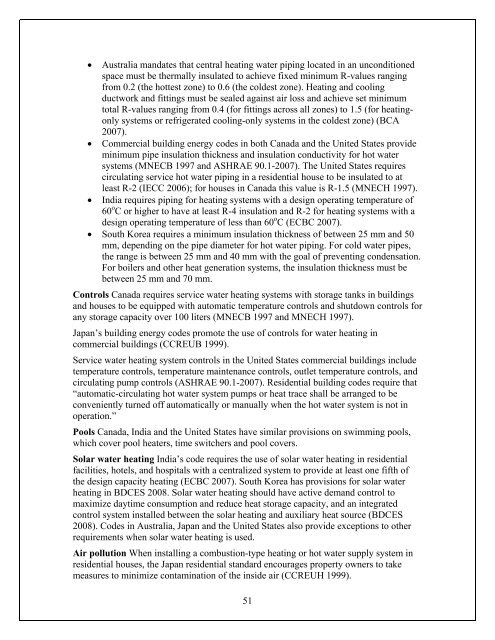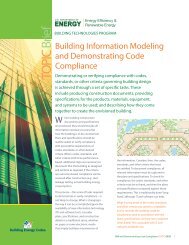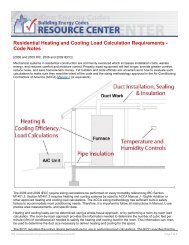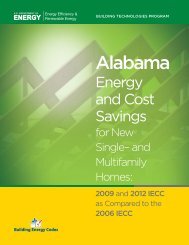Shaping the Energy Efficiency in New Buildings - Building Energy ...
Shaping the Energy Efficiency in New Buildings - Building Energy ...
Shaping the Energy Efficiency in New Buildings - Building Energy ...
Create successful ePaper yourself
Turn your PDF publications into a flip-book with our unique Google optimized e-Paper software.
Australia mandates that central heat<strong>in</strong>g water pip<strong>in</strong>g located <strong>in</strong> an unconditionedspace must be <strong>the</strong>rmally <strong>in</strong>sulated to achieve fixed m<strong>in</strong>imum R-values rang<strong>in</strong>gfrom 0.2 (<strong>the</strong> hottest zone) to 0.6 (<strong>the</strong> coldest zone). Heat<strong>in</strong>g and cool<strong>in</strong>gductwork and fitt<strong>in</strong>gs must be sealed aga<strong>in</strong>st air loss and achieve set m<strong>in</strong>imumtotal R-values rang<strong>in</strong>g from 0.4 (for fitt<strong>in</strong>gs across all zones) to 1.5 (for heat<strong>in</strong>gonlysystems or refrigerated cool<strong>in</strong>g-only systems <strong>in</strong> <strong>the</strong> coldest zone) (BCA2007).Commercial build<strong>in</strong>g energy codes <strong>in</strong> both Canada and <strong>the</strong> United States providem<strong>in</strong>imum pipe <strong>in</strong>sulation thickness and <strong>in</strong>sulation conductivity for hot watersystems (MNECB 1997 and ASHRAE 90.1-2007). The United States requirescirculat<strong>in</strong>g service hot water pip<strong>in</strong>g <strong>in</strong> a residential house to be <strong>in</strong>sulated to atleast R-2 (IECC 2006); for houses <strong>in</strong> Canada this value is R-1.5 (MNECH 1997).India requires pip<strong>in</strong>g for heat<strong>in</strong>g systems with a design operat<strong>in</strong>g temperature of60 o C or higher to have at least R-4 <strong>in</strong>sulation and R-2 for heat<strong>in</strong>g systems with adesign operat<strong>in</strong>g temperature of less than 60 o C (ECBC 2007). South Korea requires a m<strong>in</strong>imum <strong>in</strong>sulation thickness of between 25 mm and 50mm, depend<strong>in</strong>g on <strong>the</strong> pipe diameter for hot water pip<strong>in</strong>g. For cold water pipes,<strong>the</strong> range is between 25 mm and 40 mm with <strong>the</strong> goal of prevent<strong>in</strong>g condensation.For boilers and o<strong>the</strong>r heat generation systems, <strong>the</strong> <strong>in</strong>sulation thickness must bebetween 25 mm and 70 mm.Controls Canada requires service water heat<strong>in</strong>g systems with storage tanks <strong>in</strong> build<strong>in</strong>gsand houses to be equipped with automatic temperature controls and shutdown controls forany storage capacity over 100 liters (MNECB 1997 and MNECH 1997).Japan’s build<strong>in</strong>g energy codes promote <strong>the</strong> use of controls for water heat<strong>in</strong>g <strong>in</strong>commercial build<strong>in</strong>gs (CCREUB 1999).Service water heat<strong>in</strong>g system controls <strong>in</strong> <strong>the</strong> United States commercial build<strong>in</strong>gs <strong>in</strong>cludetemperature controls, temperature ma<strong>in</strong>tenance controls, outlet temperature controls, andcirculat<strong>in</strong>g pump controls (ASHRAE 90.1-2007). Residential build<strong>in</strong>g codes require that“automatic-circulat<strong>in</strong>g hot water system pumps or heat trace shall be arranged to beconveniently turned off automatically or manually when <strong>the</strong> hot water system is not <strong>in</strong>operation.”Pools Canada, India and <strong>the</strong> United States have similar provisions on swimm<strong>in</strong>g pools,which cover pool heaters, time switchers and pool covers.Solar water heat<strong>in</strong>g India’s code requires <strong>the</strong> use of solar water heat<strong>in</strong>g <strong>in</strong> residentialfacilities, hotels, and hospitals with a centralized system to provide at least one fifth of<strong>the</strong> design capacity heat<strong>in</strong>g (ECBC 2007). South Korea has provisions for solar waterheat<strong>in</strong>g <strong>in</strong> BDCES 2008. Solar water heat<strong>in</strong>g should have active demand control tomaximize daytime consumption and reduce heat storage capacity, and an <strong>in</strong>tegratedcontrol system <strong>in</strong>stalled between <strong>the</strong> solar heat<strong>in</strong>g and auxiliary heat source (BDCES2008). Codes <strong>in</strong> Australia, Japan and <strong>the</strong> United States also provide exceptions to o<strong>the</strong>rrequirements when solar water heat<strong>in</strong>g is used.Air pollution When <strong>in</strong>stall<strong>in</strong>g a combustion-type heat<strong>in</strong>g or hot water supply system <strong>in</strong>residential houses, <strong>the</strong> Japan residential standard encourages property owners to takemeasures to m<strong>in</strong>imize contam<strong>in</strong>ation of <strong>the</strong> <strong>in</strong>side air (CCREUH 1999).51
















